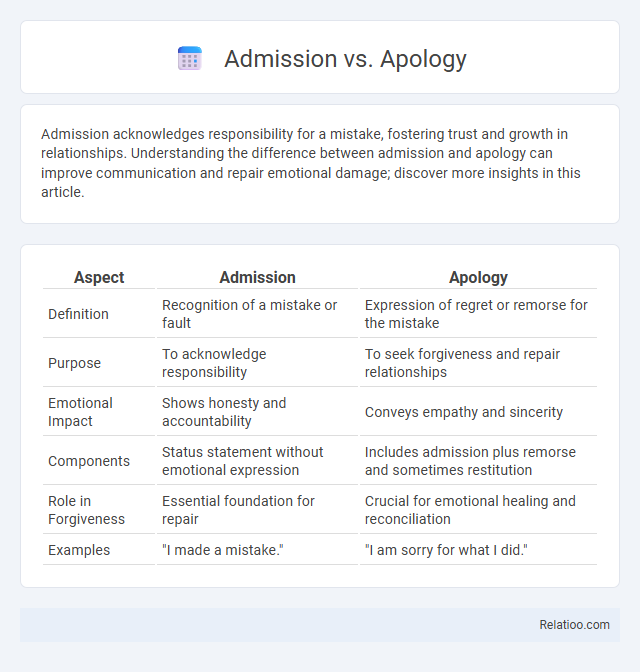Admission acknowledges responsibility for a mistake, fostering trust and growth in relationships. Understanding the difference between admission and apology can improve communication and repair emotional damage; discover more insights in this article.
Table of Comparison
| Aspect | Admission | Apology |
|---|---|---|
| Definition | Recognition of a mistake or fault | Expression of regret or remorse for the mistake |
| Purpose | To acknowledge responsibility | To seek forgiveness and repair relationships |
| Emotional Impact | Shows honesty and accountability | Conveys empathy and sincerity |
| Components | Status statement without emotional expression | Includes admission plus remorse and sometimes restitution |
| Role in Forgiveness | Essential foundation for repair | Crucial for emotional healing and reconciliation |
| Examples | "I made a mistake." | "I am sorry for what I did." |
Understanding the Difference: Admission vs Apology
An admission is a statement acknowledging the truth of a fact, often related to responsibility or guilt, whereas an apology is an expression of regret or remorse for a specific action or mistake. Understanding the difference between admission and apology helps you communicate effectively by distinguishing between accepting fault and expressing empathy. Your ability to separate these concepts enhances conflict resolution and personal accountability.
Defining Admission: When to Acknowledge Responsibility
Admission involves acknowledging responsibility for an action or mistake, making it a critical step in communication and conflict resolution. Understanding when to admit fault can prevent escalation and build trust, as it demonstrates accountability and transparency. You should clearly differentiate admission from an apology by focusing specifically on owning the behavior without necessarily expressing regret.
The Essence of an Apology: More Than Just Words
An apology embodies accountability and empathy, conveying genuine remorse beyond merely admitting fault or making an admission. Unlike admission, which acknowledges an action or truth, an apology actively seeks to heal relationships by recognizing the impact on others. The essence of an apology lies in its sincerity and willingness to make amends, fostering trust and emotional reconciliation.
Psychological Impact: How Admission and Apology Affect Relationships
Admission acknowledges responsibility, fostering trust by showing honesty and self-awareness, while apology goes further by expressing regret and empathy, which can heal emotional wounds and rebuild connection in your relationships. Both admission and apology play crucial roles in repairing conflicts, but an admission without an apology may leave unresolved feelings, limiting emotional recovery. The psychological impact deepens when an apology accompanies admission, as it signals humility and respect, encouraging forgiveness and strengthening interpersonal bonds.
Legal Implications: Admission vs Apology in Liability
Admission acknowledges fault or responsibility, directly impacting liability by potentially serving as evidence in legal proceedings. An apology may express regret without admitting fault, often used to mitigate tension while avoiding legal liability. Understanding this distinction is crucial in legal contexts, as admission can lead to increased liability exposure, whereas a carefully worded apology might protect against such consequences.
Cultural Perspectives: Global Views on Admission and Apology
Admission and apology carry different cultural weights worldwide, influencing interpersonal and legal interactions. In some cultures, admission implies acknowledgment of facts without emotional expression, whereas an apology requires conveying regret to restore harmony. Understanding these nuances helps you navigate global communication more effectively and avoid misunderstandings.
The Role of Empathy: Bridging Admission and Apology
Empathy plays a crucial role in bridging admission and apology by fostering genuine understanding and emotional connection between parties. Your ability to express empathy transforms a mere admission of fault into a heartfelt apology that acknowledges the impact on others, facilitating trust and resolution. This empathetic approach ensures that accountability is not just acknowledged but also felt, promoting healing and stronger relationships.
Effective Communication: Crafting a Genuine Admission or Apology
Effective communication hinges on distinguishing between admission and apology to convey sincerity and accountability. An admission acknowledges facts or mistakes without necessarily expressing remorse, while an apology conveys empathy and regret, fostering trust and resolution. Crafting a genuine admission or apology requires clarity, ownership of actions, and a focus on the recipient's feelings to promote constructive dialogue and rebuild relationships.
Steps to Take After Admission or Apology
After making an admission, you should carefully document the details and assess any potential consequences to prepare for follow-up actions. When you offer an apology, focus on expressing sincere regret and outlining steps to rectify the issue, helping to rebuild trust. Your next steps involve clear communication, understanding the impact of your admission or apology, and implementing practical solutions to prevent recurrence.
Choosing the Right Approach: When to Admit, When to Apologize
Choosing the right approach between admission and apology depends on the context and desired outcome. Admission involves acknowledging facts or responsibility clearly, which strengthens your credibility and trustworthiness. Apologizing expresses regret for a mistake or harm caused, helping to mend relationships and demonstrate empathy to Your audience or counterpart.

Infographic: Admission vs Apology
 relatioo.com
relatioo.com